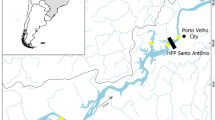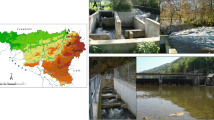Abstract
This radio telemetry study is part of a large interdisciplinary research program on the colonisation and development of the Marchfeldkanal(MFK)-system, a man made channel. The immigration of fishes into the MFK is dependent on the effectiveness of fish bypass channels at several weirs. To investigate the efficiency of the lower most fishway we estimated the population densities along the MFK-system and below the weirs using electrofishing. In addition, the movements of 15 radio-tagged pike-perch at the fishway were observed. Although more than 57000 fishes of 35 species passed the bypass channel, pike-perch (Stizostedion lucioperca) were under-represented in the fishway traps compared to their occurrence in the channel. The average daily movement of radio-tagged pike-perch was 108 m (range 6–333 m) and the maximum observed daily movement was 1050 m. The entrance to the bypass channel (280 m below the weir, and 100 m above the release site) was approached a number of times by 6 tagged fish, though none of them entered the bypass channel during the period of tracking. We conclude that although pike-perch migrate actively they do not utilise the bypass channel as much as most fish species of the MFK. Therefore the weir still represents a bottleneck for the immigration of pike-perch into the MFK.
Similar content being viewed by others
References
Baras, E., 1991. A bibliography on underwater telemetry, 1956– 1990. Can. Tech. Rep. Fish. Aquat. Sci. 1819: 55 pp.
Baras, E., H. Lambert & J. Philippart, 1994. A comprehensive assessment of the failure of Barbus barbus spawning migrations through a fish pass in the canalized River Meuse (Belgium). Aquat. Living. Resour. 7: 181–189.
Francfort, J. E., G. F. Cada, D. D. Dauble, R. T. Hunt, D. W. Jones, B. N. Rinehart, G. L. Sommers & R. J. Costello, 1994. Environmental mitigation at hydroelectric projects. Volume II. Benefits and costs of fish passage and protection. Idaho Falls, ID, U. S. Department of Energy, Idaho Operations Office.
Grubinger, H. & T. Ernegger, 1994. Interdisziplinäre Forschung am Marchfeldkanal (Ein Schwerpunktprojekt des Fonds zur Förderung der wissenschaftlichen Forschung in Wien). Wetter und Leben, Z. angew. Meteorol. 46: 185–198.
Jensen, A. J. & P. Aass, 1995. Migration of a fast-growing population of brown trout (Salmo trutta L.) through a fish ladder in relation to water flow and water temperature. Reg. Riv. Res. & Mgmt 10: 217–228.
Jungwirth, M., 1996. Bypass channels at weirs as appropriate aids for fish migration in rhithral rivers. Reg. Riv. Res. & Mgmt 12: 483–492.
Jungwirth, M. & B. Pelikan, 1989. Zur Problematik von Fischaufstiegshilfen. Österr. Was. Abfallwirt. 41: 80–89.
Larinier, M., J. P. Porcher, F. Travade & C. Gosset, 1996. Passes à poissons. Expertise, conception des ouvrages de franchissement. Conseil supérieur de la pêche, Paris, 336 pp.
Monk, B., D. Weaver, C. Thompson & F. Ossiander, 1989. Effects of flow and weir design on the passage behaviour of American shad and salmonids in an experimental fish ladder. North am. J. Fish. Mgmt 9: 60–67.
Schmutz, S., H. Mader & G. Unfer, 1995. Funktionalität von Pota-malfischaufstiegshilfen im Marchfeldkanalsystem. Österr. Was. Abfallwirt. 47: 43–58.
Schmutz, S., S. Matheisz, A. Pohn, J. Rathgeb & G. Unfer, 1994. Erstbesiedelung des Marchfeldkanals aus fischkologischer Sicht. Österreichs Fischerei 47: 158–179.
Schwalme, K., W. Mackay & D. Lindner, 1985. Suitability of vertical slot and denil fishways for passing north-temperate, nonsalmonid fish. Can. J. Fish. Aquat. Sci. 42: 1815–1822.
Travade, F., M. Larinier, S. Boyer-Bernard & J. Dartiguelongue, 1998. Experiences on four fishpass installations recently built on two rivers in southwest France. In M. Jungwirth, S. Schmutz & S. Weiss (eds), Fish Migration and Fish-Bypasses. Blackwell Scientific Publications: in press.
Winter, J., V. Kuechle, D. Siniff & J. Tester, 1978. Equipment and methods for radiotracking freshwater fish. Univ. of Minn. Agric. exp. Stn. Misc. Rep.
Rights and permissions
About this article
Cite this article
Schmutz, S., Giefing, C. & Wiesner, C. The efficiency of a nature-like bypass channel for pike-perch (Stizostedion lucioperca) in the Marchfeldkanalsystem. Hydrobiologia 371, 355–360 (1998). https://doi.org/10.1023/A:1017091625603
Issue Date:
DOI: https://doi.org/10.1023/A:1017091625603




